#Les Abbesses
Text

#la mouette#tchekhov#Чайка#The Seagull#anton chekhov#theather#théâtre#Les Abbesses#play#scene#en scène
0 notes
Photo

REVIZORS Chez Clint le 25 juin 2022
#REVIZORS#le revizor#chez clint#les abbesses#montmartre#concert bar#power trio#basse guitare batterie#1234
0 notes
Text
youtube
LA ABADESA (2024)
Synopsis
In the 9th century, Emma of Barcelona (c. 880-942), a 17-year-old girl, is named abbess in order to repopulate and Christianize border territories in 897. Upon arriving at the abbey, she will have to overcome the mistrust aroused by a woman determined to fulfill her mission, which will lead her to confront nobles, like her brother Count Guifré II Borrel of Barcelona (874-911), peasants and the nuns themselves. Despite everything, Emma will show that it is possible to challenge established power structures. Although she will pay a high price to get it...
Emma is willing to carry out the commission of her deceased noble father, Count Guifré I of Barcelona, Guifré el Pilós (840-897), founder of the House of Barcelona: convert the abbey that he founded in 885, the Monastery of Sant Joan de les Abadesses, for which she is now responsible into the engine of change and transformation of a society that comes down. She must help with all her resources to help the lands that are emptied due to hunger caused by border wars, which in turn are a consequence of the ambitions of the feudal lords of the area.
Emma acquired small or large properties with which the monastery came to have a territory equivalent to that of a county. Her sovereignty was also similar to that of a countess: by concession from her father, her domains were exempt from all interference from the neighboring counts, whom she knew how to oppose with resistance.
On cinemas: Friday 22 March
Filming began in January 2023 at the Loarre Castle, and included scenes filmed at the Turó de la Seu Vella, until concluding at the end of February 2023.
Main cast
Emma of Barcelona - Daniela Brown
Eloisa - Blanca Romero
Guifré II Borrel of Barcelona - Carlos Cuevas
Eduard - Ernest Villegas
Odón - Oriol Genís
Bishop Gotmar of Vic– Joaquín Notario
Clara-Berta Sánchez Bajona
Melisenda - Anäel Snoek
Elvira- Olivia Auclair
Data sheet
Script and direction: Antonio Chavarrías
Produced by: Antonio Chavarrías, Jose María Morales, Miguel Morales, Mónica Lozano
Photography direction: Julian Elizalde
Editing: Clara Martínez Malagelada
Music: Ivan Georgiev
Casting: Irene Roqué, Carla Bisart, Sara Bisart, Elena Gómez Zarzuca and Doriane Flamand
Direct sound: Elsa Ruhlmann
Sound editing: Corinne Dubein
Blends: Emmanuel de Boissieu
Art direction: Irene Montcada
Costumes: Catherine Marchand and Pau Aulí
VFX: Natacha Brohan
Assistant director: Falele Ygueravide
Production direction: Anna Boneta
Executive producers: Alba Bosch-Durán, Flavia Biurrun and Jennifer Ritter
Co-producer: Huber Toint, Alex Verbaere, David Claikens, Samuel Feller
Production of Oberon Media, Wanda Films, Icono 2020, Saga Film, RTVE and TV3.
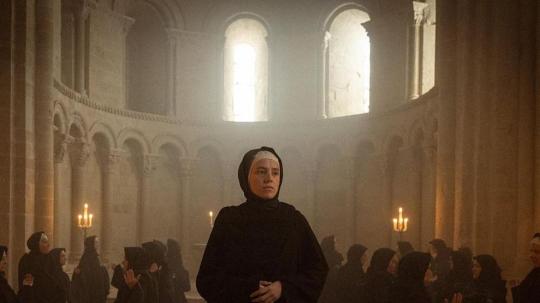



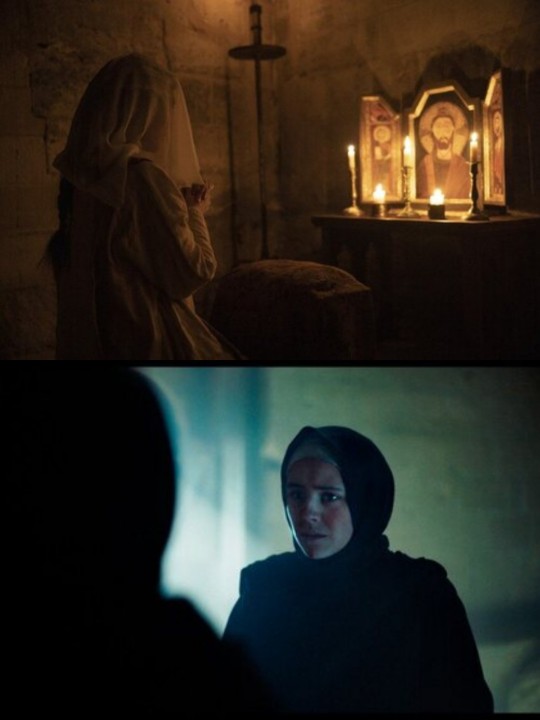




Poster

(Based on a true story/ Based on a true woman)
#the abbess#la abadesa#la abadesa 2024#period dramas#films#emma of barcelona#guifré ii borrel of barcelona#bishop gotmar of vic#antonio chavarrías#daniela brown#blanca romero#carlos cuevas#ernest villegas#oriol genís#joaquín notario#anäel snoek#9th century#berta sánchez bajona#olivia auclair#emma de barcelona#guifré ii borrel de barcelona#guifré ii de barcelona#guifré ii of barcelona#guifré i of barcelona#guifré i de barcelona#guifré el pilós#Sant Joan de les Abadesses#siglo ix
9 notes
·
View notes
Text

-Le Clos des Abbesses-
25 notes
·
View notes
Text
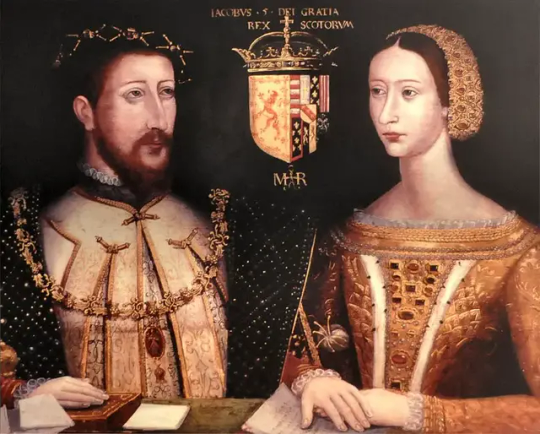




22nd February 1540 saw Marie de Guise crowned Queen Consort of Scotland at Holyrood Abbey in Edinburgh.
James V’s first French bride, Madeleine of Valois, died in the summer of 1537. James had travelled to France to meet his first bride Madeleine but also had the opportunity to meet Mary of Guise. It was reported that Mary of Guise was second in his affections.
Mary avoided the marriage to James’s maternal uncle Henry VIII and went on in May 1538 to marry James by proxy in Paris, and later married him in person after her arrival in Scotland. Mary brought with her a dowry given by Francis I of France, father of James V’s first bride, and it was large enough to be of the same value as a French princess.
Of Mary of Guise, Margaret Tudor, the King’s mother, wrote to her brother Henry VIII, “I trust she will prove a wise Princess. I have been much in her company, and she bears herself very honourably to me, with very good entertaining.” Mary lefte behind her three-year-old son, who was now the Duke of Longueville, the half brother of the future Mary Queen of Scots, in the care of her mother, Antoinette de Bourbon
Mary’s coronation happened on this day 1540. She was pregnant at the time with her first son by King James.
A new crown was made for the occasion, which was set to take place in Holyrood Abbey. Ladies were summoned from all over Scotland to attend. The abbey was hung with tapestries, and items moved for the occasion from the Holyrood Palace chapel to Holyrood Abbey. A thirty-gun salute marked the occasion, and fireworks were lit at the other end of the Royal Mile up the hill at Edinburgh Castle. Mary used a gilded sceptre for the coronation, too.
Mary had a second son in 1541 with James V, and tragically, both of her sons died on the 21st April 1541, the elder boy being not quite a year and the younger being only a few days old.
Mary of Guise was Queen Consort of Scotland for less than five years before her husband died after the Battle of Solway Moss. This famously left the couple’s six-day-old daughter, Mary, as Queen of Scots. Mary of Guise had the Queen of Scots smuggled out of Scotland and to France when the child was about five years old.
Mary of Guise served as regent for her daughter from 1554 until 1560, while the Queen of Scots was being raised at the French court,
She passed away in 1560 and her body was returned to France and given to her sister Renee, abbess of the the church of Saint-Pierre-les-Dames, Reims, where she was interred in July 1561. A marble tomb was erected with a bronze statue of Mary, in royal robes, holding a sceptre and the rod of justice in one hand.
The tomb was destroyed during the French revolution.
18 notes
·
View notes
Note
le sacré cœur?
Ahhh Le sacré cœur. Quand je suis venu passer mes oraux de prépa il y a presque dix ans je suis allée visiter Montmartre et le parterre de la butte était réservé pour tourner la scène de mariage d'un Bollywood. Sympa je me disais, avant de me faire agripper le poignet par un de ces connards qui cherchent à te forcer à acheter leurs bracelets brésiliens de merde là. Ensuite j'ai visité la basilique et j'étais soufflée par la beauté de l'artisanat à l'intérieur. Et ensuite j'ai appris son rôle de rappel à l'ordre et de soutien à la répression de la commune de Paris, et comme célébration du massacre et eumh. Vachement moins sympa.
Je dirais qu'elle vaut le coup une fois, parce que effectivement c'est joli à l'intérieur, et après c'est plutôt sympa de regarder un peu la vue panoramique de la haut, de descendre sur la gauche dans le petit chemin qui ressemble à une forêt vierge (attention ça glisse vraiment de ouf), ou alors de reprendre la route par derrière pour chercher le buste de Dalida et le passe-muraille plus loin. Le quartier de Montmartre en soi est plutôt joli, mais mes trucs pref c'est le marché saint pierre pour tous les tissus et la mercerie, et le petit patio du jardin des abbesses, caché derrière le mur des je t'aime, avec tous les poteaux décorés dans la rue derrière. Aussi faut faire gaffe, c'est un coin qui a beau être hyper touristique et pratiquement piéton, les voitures et les bus ne font absolument pas attention en conduisant.
Ne t'arrête pas aux bistrots du coin par contre, le quartier des artistes fauchés est devenu le quartier des attrape riches touristes.
2 notes
·
View notes
Text
SAints&Reading: Saturday, November 18, 2023
november 5_november 18
THE HOLY MARTYRS GALAKTION AND EPISTIMIA (253)

There was a rich and distinguished couple named Kletophon and Leukippe, who lived in the Syrian city of Emesa, and for a long time they were childless. They gave much gold to the pagan priests, but still they remained childless.
The city of Emesa was governed by a Syrian named Secundus, put there by the Roman Caesars. He was a merciless and zealous persecutor of Christians, and to intimidate them he ordered that the instruments of torture be displayed on the streets. The slightest suspicion of belonging to “the sect of the Galilean” (as thus Christians were called by the pagans), was enough to get a man arrested and handed over for torture. In spite of this, many Christians voluntarily surrendered themselves into the hands of the executioners, in their desire to suffer for Christ.
A certain old man by the name of Onuphrius concealed his monastic and priestly dignity beneath his beggar’s rags. He walked from house to house in Emesa, begging alms. At the same time, whenever he saw the possibility of turning people away from the pagan error, he preached about Christ.
Once, he came to the magnificent house of Leukippe. Accepting alms from her, he sensed that the woman was in sorrow, and he asked what was the cause of this sadness. She told the Elder about her familial misfortune. In consoling her, Onuphrius began to tell her about the one true God, about His omnipotence and mercy, and how He always grants the prayer of those turning to Him with faith. Hope filled the soul of Leukippe. She believed and accepted Holy Baptism. Soon after this it was revealed to her in a dream that she would give birth to a son, who would be a true follower of Christ. At first, Leukippe concealed her delight from her husband, but after the infant was born, she revealed the secret to her husband and also persuaded him to be baptized.
They named the baby Galaction and his parents raised him in the Christian Faith and provided him a fine education. He could make an illustrious career for himself, but Galaction sought rather an unsullied monastic life in solitude and prayer.
When Galaction turned twenty-four, his father resolved to marry him off and they found him a bride, a beautiful and illustrious girl by the name of Episteme. The son did not oppose the will of his father, but by the will of God, the wedding was postponed for a time. Visiting his betrothed, Galaction gradually revealed his faith to her. Eventually, he converted her to Christ and he secretly baptized her himself.
Besides Episteme he baptized also one of her servants, Eutolmius. The newly-illumined decided on the initiative of Galaction, to devote themselves to the monastic life. Leaving the city, they hid themselves away on Mount Publion, where there were two monasteries, one for men and the other for women. The new monastics had to take with them all the necessities for physical toil, since the inhabitants of both monasteries were both old and infirm.
For several years the monastics struggled in work, fasting and prayer. Once, Episteme had a vision in her sleep: she and Galaction stood in a wondrous palace before a radiant King, and the King bestowed golden crowns on them. This was a prefiguring of their impending martyrdom.
The pagans became aware of the existence of the monasteries, and a military detachment was sent to apprehend their inhabitants. But the monks and the nuns succeeded in hiding themselves in the hills. Galaction, however, had no desire to flee and so he remained in his cell, reading Holy Scripture. When Episteme saw that the soldiers were leading Galaction away in chains, she began to implore the Abbess to permit her to go also, since she wanted to accept torture for Christ together with her fiancé and teacher. The Abbess tearfully blessed Episteme to do so.
The saints endured terrible torments, while supplicating and glorifying Christ. Their hands and legs were cut off, their tongues were cut out, and then they were beheaded.
Eutolmius, the former servant of Episteme, and who had become her brother in Christ and fellow ascetic in monastic struggles, secretly buried the bodies of the holy martyrs. He later wrote an account of their virtuous life and their glorious martyrdom, for his contemporaries and for posterity.
HIEROMARTYR SILVANUS, BISHOP OF GAZA (circa 311)

Saint Silvanus came from the vicinity of the city of Gaza, and was a soldier. Desiring to serve the heavenly King, he became a priest, and was consecrated Bishop of Gaza. Saint Silvanus converted many pagans to Christ. During the persecution against Christians under the emperor Diocletian he was taken for trial to the city of Caesarea. He underwent torture and bravely endured it, and was then sentenced to harsh labor in the copper mines.
The holy bishop was exhausted by this work, but remained cheerful of spirit. He incessantly preached Christ to all those around him. This angered the pagans, who beheaded him.
Forty holy martyrs, who believed in Christ after hearing the words of the bishop, were also martyred with him. Their death followed in the year 311.
Source: orthodox Church in America_OCA


2 CORINTHIANS 11:1-6
1 Oh, that you would bear with me in a little folly-and indeed you do bear with me. 2 For I am jealous for you with godly jealousy. For I have betrothed you to one husband, that I may present you as a chaste virgin to Christ. 3 But I fear, lest somehow, as the serpent deceived Eve by his craftiness, so your minds may be corrupted from the simplicity that is in Christ. 4 For if he who comes preaches another Jesus whom we have not preached, or if you receive a different spirit which you have not received, or a different gospel which you have not accepted-you may well put up with it! 5 For I consider that I am not at all inferior to the most eminent apostles. 6 Even though I am untrained in speech, yet I am not in knowledge. But we have been thoroughly manifested among you in all things.
LUKE 9:1-6
1 Then He called His twelve disciples together and gave them power and authority over all demons, and to cure diseases. 2 He sent them to preach the kingdom of God and to heal the sick. 3 And He said to them, "Take nothing for the journey, neither staffs nor bag nor bread nor money; and do not have two tunics apiece. 4 Whatever house you enter, stay there, and from there depart. 5 And whoever will not receive you, when you go out of that city, shake off the very dust from your feet as a testimony against them. 6 So they departed and went through the towns, preaching the gospel and healing everywhere.
#orthodoxy#orthodoxchristianity#easternorthodoxchurch#originofchristianity#spirituality#holyscriptures#gospel#bible#wisdom#saints
3 notes
·
View notes
Text
Some post Louis XIV fashion -

1715 Jeanne-Cecil Le Guay de Montgermon, three quarter length in a white satin robe with gold trimming and a ruby and pearl brooch by Nicolas de Largillière (Robilant & Voena, specific location ?). From their Web site; From their Web site; fixed spots in background with Photoshop and increased color saturation. 2721X3532.

1716 Mary Josephine Drummond, condesa de Castelblanco by Jean Baptiste Oudry (Museo del Prado - Madrid, Spain). From their Web site;fixed spots w Pshop 2045X2717.

ca. 1715 Louise Adélaïde de Bourbon by Pierre Gobert (Châteaux de Versailles et de Trianon - Versailles, Île-de-France, France) photo - Gérard Blot. From Réunion des Musées nationaux; enlarged by half 726X956.

ca. 1715 Sarah Lascelles (1656/1659–1743), Mrs Joshua Iremonger II, then Mrs Christopher Lethieullier by Michael Dahl I (Uppark House and Garden - South Harting, Petersfield, West Sussex, UK). From bbc.co (now artuk.org) 652X800.
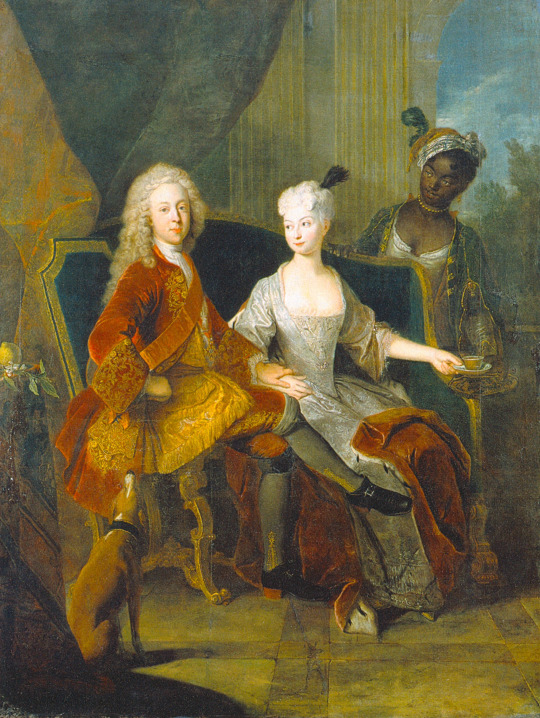
ca. 1716 Friedrich Ludwig of Württemberg and his wife Henriette Marie of Brandenburg-Schwedt by Antoine Pesne (Staatliches Museum Schwerin - Schwerin, Mecklenburg-Vorpommern, Germany). From Wikimedia; removed spots and linear and splotch flaws with. Photoshop 2078X2763.
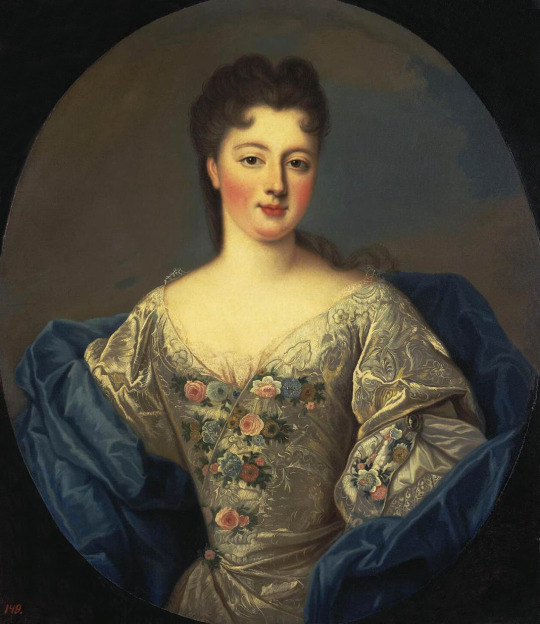
ca. 1716 Marie Louise Adélaïde d'Orléans the future Abbess of Chelles, daughter of the Regent of France by Pierre Gobert (Domaine de Sceaux - Sceaux, Hauts-de-Seine, Île-de-France, France). From Wikimedia; fixed spots w Pshop 1069X1235.

ca. 1717 Madame de Ventadour by Pierre Mignard (Châteaux de Versailles et de Trianon - Versailles, Île-de-France, France). From Wikimedia 1516X2000.The abundant lace ruffles on her sleeves point to the future while the headdress looks back to Fontanges and cleft coiffures.

Lady, said to be Marie-Elisabeth Le Fèvre de Caumartin (d. 1717) by Nicolas de Largillière (Sotheby's - 13Jun07 auction Lot 56). From their Web site; fixed obvious spots & cracks w Pshop 2396X2866.
#1710s fashion#late Baroque fashion#Rococo fashion#Georgian fashion#Louis XV fashion#Nicolas de Largillière#Jean Baptiste Oudry#Michael Dahl#Antoine Pesne#Pierre Gobert#Pierre Mignard
3 notes
·
View notes
Text
“…Pregnant women can generally feel their fetus move at around 18 weeks of gestation; in the Middle Ages, when women’s periods might be irregular for many reasons and recollections of when a sex act took place hazy, it was an incredibly subjective and personal measurement.
Medical texts were similarly vague: Aristotle, for instance, held that quickening took place at 40 days for male fetuses and 80 for female. And, since the line between pregnancy and a period that might have been missed for other reasons was vague, remedies to “restore the menses” before quickening – the same terminology used by the 19th century – abounded. No less an authority than the twelfth-century abbess Hildegard of Bingen provided recipes, as did Peter of Spain.
(Note that today, “viability,” the point before which 1992’s Casey decision holds that abortion ought to be legal in all circumstances, is considered to happen at 24 weeks.) While some Church authorities did consider abortion at any stage a mortal sin, the twelfth-century Decretum written by Church lawyer Gratian declared “he is not a murderer who brings about abortion before the soul is in the body” (i.e., quickening).
This idea of “quickening” was passed down into medieval and early modern English law, and was a distinctly medieval innovation: Roman law, as well as early Germanic law codes such as the Visigothic, Salic, and Bavarian, forbade abortion under harsh penalties.
As with nineteenth-century bans, this was as much out of concern for the mother as for the fetus, since early medieval medical abortion was accounted dangerous. At the same time, as Roland Betancourt discusses, embryotomy – true “partial-birth” abortion, cutting apart a viable fetus so that the mother would not perish in childbirth – was seen as a necessary evil.
Carla Spivack does an excellent job of contextualizing and refuting arguments about the supposed illegality of abortion in early modern England. To summarize her claims: jurists’ concern was by and large for illicit sex, not abortion; the cases cited by those making an anti-choice case are for those who destroyed either newborns or fully-formed, “quickened” fetuses, and/or women who died from taking dangerous concoctions of herbs; the line between pregnancy and merely missing periods or having an abnormal growth was not well-defined; and herbal recipes for what is today called “medicine abortion,” which was conflated with restoring normal, healthy menstruation, were common and well-known. Further, a fetus in the early stages of development was not even considered to be human.
Spivack bolsters her case with numerous primary sources, as well as contextual analysis. Alfred the Great’s law code from the ninth century specifies that anyone who kills a pregnant woman would pay full wergeld for the woman and half for the child; the context of this is not the fetus’ personhood, but loss of property and reproductive services. Following contemporary theology, Henry I’s twelfth-century laws specify different penalties for abortion before and after quickening at forty days—three years of penance versus seven. This, however, was an ecclesiastical penalty for a moral crime—not a legal punishment for the act itself.
If we look to criminal law, the tremendously influential thirteenth-century jurist Henry of Bracton, who sought to systematize English common law, distinguished between pre- and post-quickened fetuses; for Bracton, destroying a fetus before quickening was not considered murder.
The Tudor jurist William Stanford in his 1560 Les Plees del Coron and the Elizabethan Edward Coke in his Reports (published from 1600 to 1615), as well as the seventeenth-century Matthew Hale in his posthumous History of the Common Law in England, agreed with this reading, calling it a “misprision” (misdemeanor), not homicide. All three of these authors were known to America’s Founding Fathers, particularly Jefferson.
Another inarguable influence on American law, William Blackstone’s great commentary on English law published in 1765, picked up the thread: the law did not take an infant into consideration at all before it was able to “stir in the mother’s womb”; after quickening, it was a “a very heinous misdemeanor” to kill the child.
In fact, though anti-choice writers such as Joseph Dellapenna cite criminal cases in which men were prosecuted for having caused miscarriages or stillbirths, as Spivack points out, this was for harm to the woman or to a quickened fetus – not damage to a pre-quickened pregnancy. Other sources cited by anti-choice camp include the Malleus Maleficarum, which charged witches with aborting fetuses through magic and herbs – though for the anti-choice camp to cite a witch-hunting manual seems apt.
In other words, quite to the contrary of what Alito alleges, there is absolutely no grounds in common law, which reaches back to medieval jurisprudence, to overturn Roe v. Wade. Making such an argument not only lays bare the purely political nature of the decision; by cherry-picking sources, it weakens the originalist school of Constitutional law as a whole.”
- Ken Mondschein, “The Past and Present of Abortion in Medieval Law.”
21 notes
·
View notes
Text
Le Fresne live react
This one's a bit more direct of a moral tale, at least to start, than the "reader, make your own judgment" of Equitan.
There are two knights. They're neighbors, they're both rich and powerful, bold and valiant, etc etc. One knight's wife has twin sons. Her husband is elated and sends word to his neighbor, asking him to be the godparent of the sons.
However, the neighbor wife is "false and proud and backbiting and envious", and says essentially that having twins means a woman cheated on her husband, because "nor will it chance to happen that in one single pregnancy a woman should have two sons, unless two men have done this to her".
Hard to tell if this is common wisdom, or if she's just making it up. Her husband says don't say that, the neighbor lady has a good reputation. But everyone gossips about it and believes that the mother of twin sons definitely had an affair, and even her husband believed it, "and greatly mistrusted her, and kept her closely confined without her deserving it".
Well, the same year, the gossip lady gets pregnant and has twin daughters, which she's very distressed about, because, well:

Gossip lady is terribly shitty. "I'm gonna gossip about this other woman because I'm jealous!" "Oops now I'm in the same position, shouldn't have gossiped, guess I have no choice but to kill one of my twins to cover it up," like, what?? That's your first thought?

Oh good, another competent interesting servant character. Hopefully she sticks around for the whole poem, but I doubt it.
So the lady is happy that she doesn't have to kill her infant, and says she'll reward the maiden for taking her child to a church. So they wrap up the child with fancy cloth ("very fine linen" and "a patterned silk cloth" that her husband had brought back from Constantinople), and the lady ties a heavy gold ring to the baby's arm with a red zircon in the setting, so that anyone who found the child would know she was born to a noble family.
The infant is stashed in an ash tree in front of an abbey and found by a porter as he's leaving the abbey. He takes her home to his widowed daughter who's still nursing, and they take care of her. He tells the abbess about it the next day and she adopts the child as her niece, names her Le Fresne (ash tree), and she's raised in that way til she's an adult.
Of course she grows up beautiful, courteous, gracious, well educated, well spoken, wise, etc (all words used in the Lai to describe her). "No one saw her who did not love her and hold her in the highest esteem."
So a lord named Gurun of Dol hears about her, falls in love without even seeing her (which seems to be a theme; I'm skeptical of it but I suspect I should internalize it when reading Arthurian literature), and takes great pains to be able to talk to her. Eventually she sleeps with him after he cajoled her a bunch, and then he uses that to get her to come away with him as his mistress. (To make this worse, we're told that Le Fresne has basically never left the abbey and is very sheltered.)

This is not condemned in the text. We were told just a page earlier that he was "a good lord; never before nor since was there a better", so I'm guessing this behavior is considered acceptable and even romantic?
Different culture, different time, different morals. But still. That's some dubious consent and sketchy behavior right there.
So Le Fresne goes off with the baby cloths and ring she'd been found with sealed up in coffers, and spends a long time with Gurun, and everyone loves her "for her graciousness" and cherishes and honors her. But the knights say the lord should get rid of her and marry a noblewoman.
Who does he get matched with except… Le Codre. Which means the hazel tree. Her twin sister.
(Lais: the original soap operas?)
Le Fresne stays gracious through the news, keeps serving the lord "most kindly" and honoring the people, and the whole household is very upset that they're going to lose her.
Gurun and Le Codre get married. The mother goes with Le Codre because she's worried Gurun's mistress will make trouble.
Le Fresne's serving her unknown sister, everyone's amazed that she can be so courteous. Even her mother loves her and wishes she wouldn't have suffered loss for Le Codre's sake, she wouldn't have agreed to the match if she'd known the sort of person Le Fresne was. Which is a big deal, since you might remember what a petty person the mother was in the past. (Maybe she's changed her ways.)
Le Fresne prepares the bridal chamber. There's an old silk coverlet on it, and Le Fresne thinks it's too shabby for her lord. So she puts her birth cloth over it instead, to honor him.
Good thing, too, because the mother brings Le Codre over and is absolutely shocked to find the silk cloth she gave her hidden daughter.

She admits to her misdeed to her husband, who's actually really happy to learn he has another daughter. They tell Sir Gurun, who's also joyful.
The archbishop says to leave things as they are for the night, and he'll separate them the next day, and then Gurun can marry Le Fresne. (Does that mean Gurun and Le Codre sleep together for a night? What does that mean for Le Codre (sometimes written as La Codre in different parts of the text)? How does she feel about this?)

Well, all right, I guess?
This one read very much like a fairy tale to me. Kind of Cinderella in a lot of ways. I mean, the adoptive mother (the abbess) is way better than the birth mother, there are no stepparents, and the dad's still alive, etc. But the feel is similar.
3 notes
·
View notes
Photo

Hildegarde de Bingen
Hildegarde de Bingen (également connue sous le nom de Hildegarde von Bingen, 1098-1179) était une mystique chrétienne, une abbesse bénédictine et une polymathe maîtrisant la philosophie, la composition musicale, l'herboristerie, la littérature médiévale, la cosmologie, la médecine, la biologie, la théologie et l'histoire naturelle. Elle a refusé d'être définie par la hiérarchie patriarcale de l'Église et, bien qu'elle ait respecté ses règles, elle a repoussé les limites établies pour les femmes presque jusqu'à leur paroxysme.
Lire la suite...
2 notes
·
View notes
Text

VENECIA
En la roja Venecia,
no hay proa que se meza,
ni al largo un pescador,
con su farol.
Sólo guarda la playa
el gran león que rampa
sobre el confín sereno
su pie cobreño.
Y en redor suyo bandas
de navíos y lanchas,
a las garzas parejos,
posan en cercos
durmiendo sobre el agua,
y cruzan la vaharada
con leves revoleras
de sus banderas.
La luna que se emboza
la frente sigilosa
con celaje estrellado,
hurta su paso.
De suerte la abadesa
de su cogulla espesa
se cala los ribetes
sobre el roquete.
Y los viejos palacios,
y los adustos atrios,
y blancos graderíos
de los patricios,
y los puentes, las rúas,
las estatuas ceñudas,
y el ondulante golfo
que mueve el ostro,
callan, no así los guardas
de pinas alabardas,
velando el matacán
del arsenal.
[...]
*
VENISE
Dans Venise la rouge,
Pas un bateau qui bouge,
Pas un pêcheur dans l’eau,
Pas un falot.
Seul, assis à la grève,
Le grand lion soulève,
Sur l’horizon serein,
Son pied d’airain.
Autour de lui, par groupes,
Navires et chaloupes,
Pareils à des hérons
Couchés en ronds,
Dorment sur l’eau qui fume,
Et croisent dans la brume,
En légers tourbillons,
Leurs pavillons.
La lune qui s’efface
Couvre son front, qui passe
D’un nuage étoilé
Demi-voilé.
Ainsi la dame abbesse
De Sainte-Croix rabaisse
Sa cape aux larges plis
Sur son surplis.
Et les palais antiques,
Et les graves portiques,
Et les blancs escaliers
Des chevaliers,
Et les ponts, et les rues,
Et les mornes statues,
Et le golfe mouvant
Qui tremble au vent,
Tout se tait, fors les gardes
Aux longues hallebardes,
Qui veillent aux créneaux
Des arsenaux.
[...]
Alfred de Musset
di-versión©ochoislas
#Alfred de Musset#literatura francesa#poesía romántica#Venecia#nocturno#calma#silencio#sigilo#di-versiones©ochoislas
6 notes
·
View notes
Text
Très chouette billet sur mes chimères sauvages (et belle collection de créatures!!) sur le blog Montmartre Secret… Merci 🙏 🙏🙏
#streetart#codexurbanus#graffiti#codex#codex urbanus#street art#arturbain#picoftheday#vandal#streetartparis#paris graffiti#montmartre#arteurbano#street artist#graffitiart#paris street art#streetarteverywhere#parisstreetart#streetartists#bestiary
2 notes
·
View notes
Photo



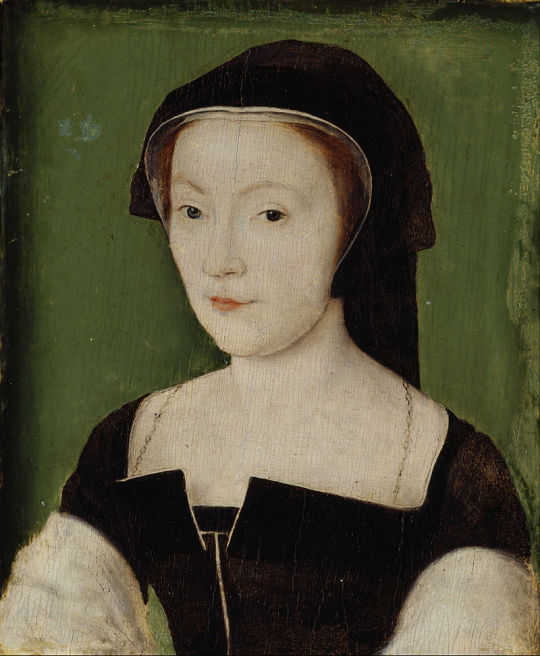

Marie Of Lorraine, also called Mary Of Guise/ Marie De Lorraine, or De Guise was born on November. 22nd, 1515 at Bar-le-Duc, Lorraine, France.
The daughter of Claude of Lorraine, Duc de Guise and Antoinette of Bourbon, Marie first married Louis D'Orleans, duc de Longueville in 1534, by whom she had two sons. After the duc's death in 1537, she was pursued for marriage by Henry VIII and James V, allegedly refusing Henry VIII's proposal by saying "I fear my neck is too small."
She wed James V of Scotland by proxy in Paris in May of 1538, and in person at St. Andrews on June 12th of that year. Their two sons, James and Arthur, died within weeks of one another in 1541. The king died in December of 1542, a week after the birth of their daughter and heir to the throne, Mary, Queen of Scots.
Mary of Guise replaced the ineffectual James Hamilton, Earl of Aran as regent in 1554, and arranged for the marriage of her daughter to the French dauphin. A Roman Catholic, she pursued pro-French policies, which embroiled her in civil war with the protestant Scottish nobles.
She was deposed on religious grounds in 1559. Suffering from dropsy, Mary died at Edinburgh Castle at the age of just 44. Her body was returned to France and given to her sister Renee, abbess of the Convent of the Abbaye Saint-Pierre-les-Dames which was completely destroyed during the French Revolution.
8 notes
·
View notes

